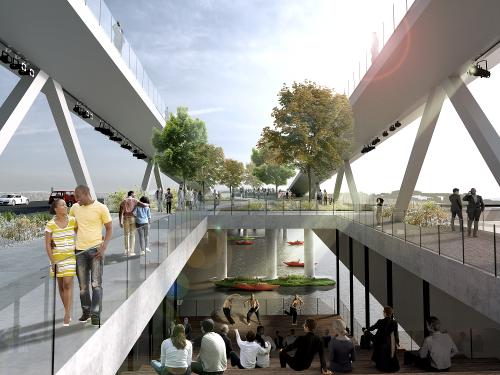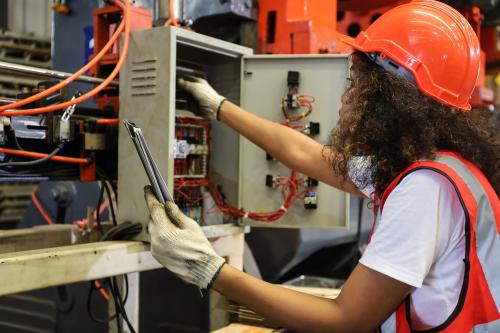You might be getting whiplash from the latest takes: millennials, a driving force behind the revival of cities, are now fleeing for the suburbs? While the latest census data do show this geographic phenomenon, we should be careful about using an old framing–city versus suburb–to understand a new trend: the growing market for walkable urban places found both in traditional downtowns and increasingly throughout metro areas with multiple cores.
The Center for Real Estate and Urban Analysis recently released a new report, Foot Traffic Ahead 2019, that offers fresh insight into these trends. The report looks at growth patterns in the 30 largest metropolitan areas and provides hard evidence that more walkable places—in cities and suburbs alike—are growing in number and are in high demand. Its findings suggest that to truly understand who is moving where, we should be looking at the attributes of places rather than the arbitrary jurisdictional boundaries that separate them.
Why walkability?
Our report identifies 761 regionally significant, walkable urban places (or what we refer to as WalkUPs) in the 30 largest U.S. metropolitan areas and shows that despite occupying less than 1% of land mass in these metro areas, WalkUPs deliver outsized economic performance. We rank the 30 largest metro areas on their current levels of walkable urbanism and find that New York City, Denver, Boston, Washington, D.C., the San Francisco Bay Area, and Chicago rank highest.
The demand for and benefits of walkability extend beyond these big metro areas, however.
Indeed, the report demonstrates that metro areas with more and bigger WalkUPs are more economically successful. Across metro areas, WalkUPs demand commercial rent premiums 75% higher than drivable suburban places. Educational attainment levels are also higher; in the top six walkable urban metro areas, 42% of the workforce has a college degree, compared to 31% of the workforce in the seven lowest ranked. These six metro areas also have a 52% GDP per capita premium higher than the seven lowest-ranked. Counter-intuitively, WalkUPs are also associated with positive indicators of social equity, as measured by housing and transportation costs and rental/for-sale housing mix.
But as our partners at Smart Growth America point out, it’s not enough to merely document the benefits of walkability. We need to build more of these mixed-use, walkable places where people of all incomes can live and be connected to jobs and economic opportunities. And we need more efforts to ensure affordability and inclusion within these places.
So, what’s next? Our findings point to significant policy implications for land use management, economic development, and social equity that regional leaders can employ to respond to growing demands for walkability.
Infrastructure investment can promote walkability, attract knowledge workers, and spur economic development
A surprise from our research was the strong performance of Denver, which ranked as the second most walkable metro area behind New York City. This can likely be tied to its recent investment in rail and bus transit. Between 2004 and the present, Denver invested $5.5 billion in light rail, commuter rail, bus rapid transit, and improved transit facilities including downtown Denver Union Station. Denver has also seen dramatic positive GDP growth anchored by the professional and business services sector.
While we do not yet know the causal connection between WalkUPs—often enabled by transit—and the knowledge economy, it is safe to say that walkability puts metro areas in a far better place to attract and retain skilled workers.
This may help explain why many metro area leaders are working to raise the funding needed to improve their transportation systems. Dallas-Fort Worth, for instance, is expanding their DART system of light rail to connect more Texans to job opportunities and other amenities. Washington, D.C. is continually expanding its Metrorail and recently committed $500 million per year in regional dedicated transportation funding. Los Angeles is implementing a multi-billion-dollar expansion of heavy rail, light rail, commuter rail, BRT and bus systems. Such examples—and many others— can serve as models for other metro areas looking to benefit from demands for walkability.
Zoning changes can help more places realize the benefits of density
Infrastructure isn’t the only necessary ingredient for walkable places. Zoning matters too, as walkable urban land development is generally illegal on the vast majority of metropolitan land. In metro Washington, D.C., for instance, zoning regulations and political opposition make it prohibitively difficult to build walkable urban places on 98% of the land.
This opposition to walkable urbanism hinders its growth and progress, despite research that shows higher density walkable urban places result in more sustainable tax bases, new economic foundations for the local economy, better climate outcomes, and better health outcomes. Furthermore, a new Brookings report found that high density places are correlated with faster job growth and greater prosperity.
Even if these arguments do not persuade opponents, our findings show that for-sale housing in WalkUPs enjoy dramatic positive price premiums, with 40%-100% price per square foot premiums for for-sale housing that is merely nearby a WalkUP.
Places need short-term, aggressive affordable housing now
Just because a place is economically successfully, though, does not mean it’s inclusive for all residents. There is a well-documented need for affordable housing, now— especially in high opportunity places like WalkUPs, where jobs are increasingly concentrated. While our analysis suggests that WalkUPs are more socially equitable due to lower household transportation costs, the rent is still “too damn high” in these places. Some ways to address housing affordability include:
- Place management organizations, such as business improvement organizations, can assume responsibility for advocating for and developing affordable housing in their WalkUPs (such as 3CDC in Cincinnati).
- City and regional leaders can legalize auxiliary housing units (granny flats), converting the millions of spare bedrooms in the country into affordable housing.
- Jurisdictions can adopt inclusionary zoning policies, which set aside 10%-20% of all new housing in a jurisdiction to be mandated as affordable to lower-income households (such as in Washington, D.C. and San Francisco).
- Governments and mission-driven nonprofits can invest land in new developments with 20-40% new affordable housing as a return on the land investment (such as in King County, Wash. and other jurisdictions).
Walkable urban development is not just for big, high-performing metro areas
The knowledge economy is concentrating in major coastal metropolitan areas, which are also the highest ranked walkable urban metro areas. But, demands for walkability are not confined to these places, nor are the benefits that walkability brings.
There are many examples of high economically performing metro areas outside of the 30 largest included in our report. These include metro areas like Boise, Idaho; Salt Lake City; Santa Fe, N.M.; Austin, Texas; Chattanooga, Tenn.; Charleston, S.C.; Columbus, Ohio; and many others. These metro areas have a common commitment to walkable urbanism, especially in downtown and downtown adjacent places. The economic payoff can be from attracting high tech knowledge companies (Salt Lake City, Austin, and Boise), tourism and retirement (Santa Fe and Charleston) or enhancing their existing finance (Columbus), manufacturing, education, or health sectors (Chattanooga). Without walkable urban placemaking and management, these small and mid-sized metropolitan economic turn arounds would likely not have happened.
Growing demands for walkable urban places are thus changing where people want to live, work, and spend their time. Our research confirms this and shows that walkable urbanism, when coupled with investments in people and placemaking, can cater to the changing preferences of both businesses and people, and bring economic success to cities and suburban areas alike.







Commentary
The economic power of walkability in metro areas
July 12, 2019